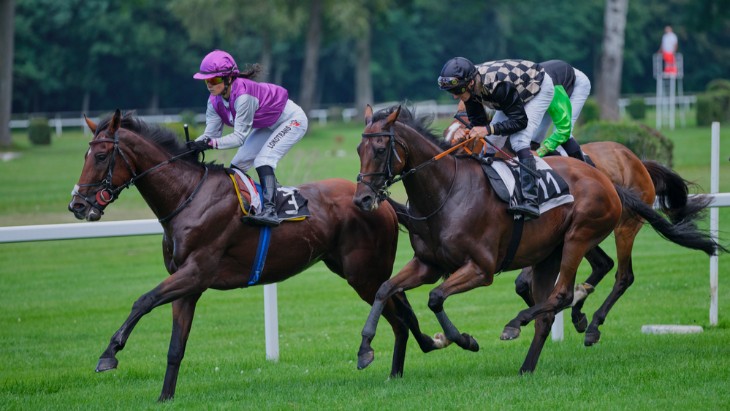- The Origins of the Term 'Bug Boy' in Horse Racing
- Understanding the Apprentice Jockey System
- The Path to Becoming a Bug Boy: Essential Criteria
- Training Regimen for Aspiring Bug Boys
- The Role of Mentors in Shaping Bug Boys
- Key Races and Milestones for Apprentice Jockeys
- The Weight Allowance Advantage: A Bug Boy's Benefit
- Challenges and Risks Faced by Bug Boys
- Notable Bug Boys in History: Success Stories
- Transition from Bug Boy to Professional Jockey
- Conclusion
The Origins of the Term 'Bug Boy' in Horse Racing
Originally, this term was coined in the United States and has since found its way into global racing vernacular. Its origin lies in the asterisk or 'bug' symbol used in race programmes to denote an apprentice jockey. This symbol, resembling a bug, would be placed next to the name of the jockey to indicate their apprentice status. This practice was pivotal in informing bettors and racing enthusiasts that the jockey was still learning the ropes and, as such, might have less experience than their professional counterparts.
Apprentice jockeys, or 'bug boys', are integral to the horse racing industry. They often start their careers at a young age, immersing themselves in the world of equine sports. These apprentices are typically allowed a weight allowance as a form of handicap against more experienced jockeys, a factor that can be both a strategic advantage and a rite of passage in the sport. The journey of these young jockeys is marked by rigorous training and a steep learning curve, as they aspire to shed their 'bug' status and rise in the ranks of professional jockeys.
Understanding the Apprentice Jockey System
The apprentice jockey system is a structured pathway for young riders to enter the competitive world of horse racing. This system serves as both a training ground and a career launchpad for aspiring jockeys. Under this system, young riders are given a unique opportunity to develop their skills, gain practical experience, and understand the nuances of horse racing under the guidance of experienced professionals. The key features of this system include:
- Licensing and Eligibility: To become an apprentice jockey, one must obtain a license from the racing authority. The eligibility criteria often include age limits, weight requirements, and basic riding skills.
- Weight Allowance: Apprentice jockeys benefit from a weight allowance, which serves to level the playing field against more seasoned jockeys. This allowance typically decreases as the apprentice gains more wins and experience.
- Mentorship: Apprentices are usually attached to a trainer or a stable, where they receive mentorship and guidance. This mentorship is crucial for their development, as it provides them with hands-on experience in managing and riding racehorses.
- Race Participation: Apprentices are encouraged to participate in races, providing them with real-world experience. These races are often pivotal in building their reputation and skill set.
- Duration and Transition: The apprenticeship lasts until the jockey achieves a set number of wins or reaches a certain age. Following this, they transition to becoming professional jockeys, no longer benefiting from the weight allowance.
This system plays a vital role in nurturing future talent in horse racing, ensuring that the sport continues to thrive with fresh and skilled jockeys entering the field regularly.
The Path to Becoming a Bug Boy: Essential Criteria
The journey to becoming a 'bug boy' in horse racing is one marked by dedication, discipline, and a deep passion for the sport. The first step in this journey involves meeting specific criteria essential for any aspiring apprentice jockey. Age is a primary factor; most apprentices begin their careers in their mid-teens, often around the age of 16, although this can vary slightly depending on racing jurisdiction. Physical fitness and a lightweight frame are also crucial, as jockeys must maintain a certain weight to compete effectively. This requirement not only ensures fair competition but also maximises the welfare and performance of the racehorses.
Beyond physical attributes, aspiring bug boys must possess a strong foundational skill in horse riding and a basic understanding of horse care and management. Many come from backgrounds with a strong equestrian influence, often having spent considerable time around horses from a young age. However, passion and determination can also lead individuals from non-equestrian backgrounds to pursue this challenging career. Once these initial criteria are met, potential apprentices usually enrol in a jockey school or training programme where they receive structured training, both theoretical and practical, in horsemanship, race riding techniques, and the intricacies of horse racing.

Training Regimen for Aspiring Bug Boys
The training regimen for aspiring bug boys is rigorous and comprehensive, designed to prepare them for the physical and mental demands of horse racing. This training encompasses various aspects, ensuring a well-rounded development of the apprentice jockey. Key components of this training include:
- Physical Fitness and Weight Management: A strict fitness regime is crucial for maintaining the lightweight physique required of jockeys. This often includes a combination of cardiovascular exercises, strength training, and specific exercises to improve balance and agility.
- Race Riding Techniques: Apprentices are trained in race riding techniques, which include starting gate practice, pace judgement, race strategy, and understanding the dynamics of a race.
- Horse Care and Management: Understanding and caring for horses is fundamental. Training includes learning about horse anatomy, nutrition, grooming, and first aid, to foster a strong bond between the jockey and the horse.
- Simulated Race Experiences: Many training programmes use horse riding simulators to mimic race conditions, allowing apprentices to practice and hone their skills in a controlled environment.
- Mental Preparedness: Horse racing can be as mentally demanding as it is physical. Training often involves building mental resilience, focus, and decision-making skills, essential for the high-pressure environment of competitive racing.
Through this multifaceted training, apprentice jockeys develop the skills, knowledge, and confidence required to navigate the challenges of horse racing, setting them on a path to potentially successful careers in this exhilarating sport.
The Role of Mentors in Shaping Bug Boys
Mentors play a pivotal role in the development of apprentice jockeys, often referred to as 'bug boys', in horse racing. These mentors, typically experienced trainers or seasoned jockeys, provide invaluable guidance, support, and insight into the complexities of the sport. They not only impart technical skills and strategies but also instil discipline, professionalism, and a deep understanding of racehorse behaviour and welfare. A mentor's influence extends beyond the race track; they help apprentices navigate the challenges of the racing world, offering advice on career decisions, race tactics, and even lifestyle choices to maintain peak physical fitness.
The relationship between a mentor and an apprentice is built on trust and mutual respect. Through regular training sessions, race debriefs, and daily interactions, mentors monitor the progress of the apprentices, providing constructive feedback and encouragement. They also play a crucial role in providing opportunities for apprentices to ride in races, often advocating for their inclusion in competitive events. This exposure is crucial for apprentices, as race experience is a key component of their development. Mentors, with their wealth of experience and industry connections, often become lifelong advisors and influential figures in the careers of these young jockeys.
Key Races and Milestones for Apprentice Jockeys
As apprentice jockeys, or 'bug boys', progress in their training, certain races and milestones become significant in their journey towards becoming professional jockeys. These key races and achievements are not only markers of their growing skill and experience but also pivotal moments that can shape their future in the sport. Important milestones and races in an apprentice jockey's career often include:
- First Race Ride: The first race ride is a significant milestone for any apprentice jockey. It is the culmination of intense training and preparation, marking their official debut in the competitive racing arena.
- First Win: Securing their first win is a major confidence booster for apprentices. It is a tangible demonstration of their skill and potential, often leading to increased opportunities from trainers and owners.
- Feature Races for Apprentices: Certain races are specifically designed for apprentice jockeys, offering them a platform to showcase their talent. Success in these races can greatly enhance their reputation and prospects within the racing community.
- Winning a Stakes Race: Winning a stakes race, which is a higher level of competitive racing involving significant prize money, is a notable achievement for an apprentice. It reflects a high level of competence and readiness for more prestigious races.
- Reaching the Win Threshold: Apprentices usually have a win threshold to achieve before they can transition to becoming professional jockeys. Reaching this threshold is a crucial milestone, signalling the end of their apprenticeship.
These milestones are not just achievements but stepping stones that build the foundation of a successful career in horse racing. They reflect the apprentice's growth, resilience, and dedication, qualities essential for anyone aspiring to make their mark in this demanding sport.
The Weight Allowance Advantage: A Bug Boy's Benefit
In horse racing, apprentice jockeys, commonly known as 'bug boys', are granted a weight allowance, a unique advantage designed to level the playing field with more seasoned jockeys. This allowance, which varies depending on the racing jurisdiction and the apprentice's experience, serves multiple purposes in the racing industry. Key aspects of the weight allowance advantage include:
- Competitive Edge: The weight allowance gives apprentice jockeys a competitive edge, compensating for their lack of experience with a lighter weight for the horse to carry. This can lead to better performance from the horse, making apprentices more appealing to trainers and owners.
- Incentive for Trainers and Owners: Owners and trainers are often inclined to use apprentice jockeys in races due to the weight advantage, providing valuable race experience for the apprentices.
- Gradual Reduction: As apprentices achieve more wins, their weight allowance is gradually reduced. This system encourages continuous improvement and progression towards becoming a professional jockey.
- Strategic Use in Races: Trainers often strategically use apprentice jockeys in certain races to exploit the weight advantage, particularly in handicap races where every pound can make a significant difference.
The weight allowance is a critical aspect of the apprentice jockey system, providing a tangible benefit that helps to nurture new talent in the sport while maintaining competitive integrity.
Challenges and Risks Faced by Bug Boys
Apprentice jockeys, known in the horse racing world as 'bug boys', face a range of challenges and risks inherent in this high-octane sport. The path to becoming a successful jockey is fraught with physical and mental hurdles that test the resilience and determination of these young athletes. One of the most significant challenges is the constant pressure to maintain a low body weight, which can lead to health issues and the need for stringent diets and exercise regimes. The physical demands of the job, coupled with the need for weight control, can sometimes lead to long-term health consequences.
Another major challenge is the risk of injury. Horse racing is inherently risky, with high speeds and close quarters increasing the likelihood of falls and accidents. For apprentice jockeys, who are still honing their skills and experience, this risk is amplified. Injuries can range from minor bruises to more serious, career-threatening conditions. Besides physical risks, apprentices also face psychological pressures. The competitive nature of the sport, coupled with the need to consistently perform and secure rides, can lead to stress and anxiety. These young jockeys must develop not only physical toughness but also mental resilience to cope with the pressures of racing and the constant scrutiny of trainers, owners, and the public.
Despite these challenges, many apprentices navigate these hurdles successfully, driven by their passion for the sport and their desire to establish themselves as professional jockeys. The journey of a 'bug boy' is as much about overcoming these risks and challenges as it is about mastering the art of horse racing.

Notable Bug Boys in History: Success Stories
Throughout the history of horse racing, numerous apprentice jockeys have made a significant impact on the sport, leaving lasting legacies. Some of these 'bug boys' have risen through the ranks to become legendary figures in racing. A few notable examples include:
- Lester Piggott: Renowned for his extraordinary career in British horse racing, Piggott began as an apprentice and quickly made a name for himself. His success as a 'bug boy' set the stage for a career that would see him win numerous prestigious races, including multiple Epsom Derby victories.
- Frankie Dettori: Another icon of British racing, Dettori started his career as an apprentice jockey. He gained fame for his remarkable riding skills and charismatic personality, eventually becoming one of the most successful jockeys in the history of the sport.
- Willie Shoemaker: An American racing legend, Shoemaker's career began as an apprentice. He went on to win numerous major races in the United States, earning a reputation as one of the greatest jockeys in American horse racing history.
- Yutaka Take: Hailing from Japan, Take's journey as an apprentice jockey saw him break numerous records in Japanese racing. His success as a 'bug boy' paved the way for a career that made him a household name in Japan and a respected figure internationally.
These jockeys exemplify the potential of apprentice jockeys to not only succeed in racing but to become influential figures in the sport. Their stories serve as inspiration for current and future generations of 'bug boys', highlighting the heights that can be reached with talent, dedication, and hard work.
Transition from Bug Boy to Professional Jockey
The transition from being an apprentice jockey, known in the racing world as a 'bug boy', to a professional jockey is a significant milestone in a rider's career. This transition is marked by several key changes and achievements, which signify the apprentice's readiness to compete at the highest levels of horse racing. Important aspects of this transition include:
- Achieving the Win Threshold: Apprentices must reach a certain number of wins to complete their apprenticeship. This threshold varies by jurisdiction but is a crucial marker of the apprentice's skill and readiness.
- Losing the Weight Allowance: Upon reaching the win threshold, apprentice jockeys lose their weight allowance. This change signifies their move to professional status, competing on equal terms with experienced jockeys.
- Increased Opportunities and Challenges: As professional jockeys, former apprentices often find more opportunities to ride in prestigious races. However, they also face increased competition and higher expectations.
- Continuous Development: The learning process doesn't stop with the transition. Professional jockeys must continue to hone their skills, adapt to new challenges, and maintain peak physical fitness to succeed in the competitive world of horse racing.
This transition is not just a change in status; it represents a significant step forward in a jockey's career, opening the door to new opportunities and greater challenges.
Conclusion
The journey of apprentice jockeys, affectionately known as 'bug boys', plays a crucial role in the world of horse racing. These young riders, through their dedication, skill, and passion, not only contribute to the vibrant tapestry of the sport but also ensure its future sustainability. The apprenticeship system, with its blend of practical experience and mentorship, prepares these individuals for the rigours and challenges of professional racing, fostering new talent that keeps the sport dynamic and exciting.
For more information:








